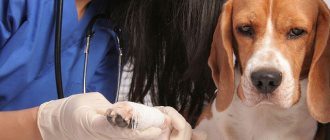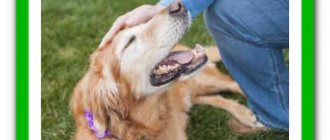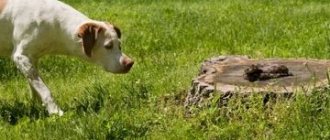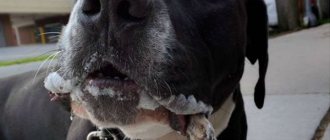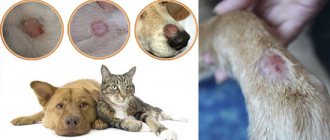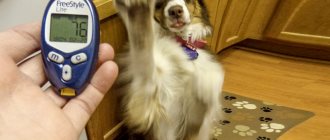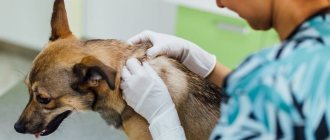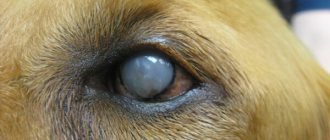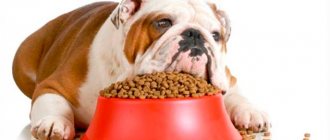Symptoms
If a dog swallows a bone and chokes, the animal will experience the following symptoms:
- the pet cannot swallow. This manifests itself during feeding. The pet begins to cough while swallowing food;
- The dog often swallows saliva. This is a protective reflex, the animal thus tries to swallow a foreign object;
- the animal whines. Most often this occurs after eating food. A foreign object can damage the intestine and pain occurs when eating food;
- cough;
- bile is secreted;
- the animal behaves lethargically, refuses food and games;
- wheezing appears when exhaling air;
- uncontrolled abundance of saliva. If an object is stuck in the throat, saliva accumulates and flows out.
Another symptom is the presence of blood in the stool. A sign appears after a sharp object damages the intestine.
Note! If any symptom appears, you should immediately contact a veterinarian.
Possible symptoms
How to help?
Is it possible to provide first aid to your pet yourself? Yes!
Of course, this can only be done if the dog feels well and does not show any signs of illness or discomfort. Otherwise, see a doctor immediately!
So you notice that your dog has swallowed a bone - what should you do in this situation? The most important thing is not to waste time, since after damage to the organ wall you will no longer be able to help the dog on your own. Your task is to prevent it from being damaged. You should not wait for stool, hoping that the bone will be safely digested or come out naturally without causing any problems, since the chances of such an outcome are low.
Let's say a dog swallowed a whole bone (chicken) or some sharp part of it. Having noticed this, you should do the following as quickly as possible. Take a candle made of wax. As a rule, such candles can only be purchased in churches. Candles sold in supermarkets and hardware stores are made from paraffin, which is not suitable for us. Why? The fact is that wax has the ability to soften and melt at a relatively low temperature (body temperature is quite enough for this). The melted wax, passing through the esophagus and entering the stomach, envelops the bones it encounters along the way, due to which the likelihood of their successful exit is significantly increased. A wax candle will help if your dog has swallowed a sharp bone or any other small sharp object.
Paraffin, alas, does not have such properties, so in this situation it will be completely useless.
So, you will have to purchase the smallest available candles from the nearest church and cut them into small circles, getting rid of the wick. The mugs should be of such a size that the dog can eat them easily. If you have a large dog, give him half a candle 3 times a day. If the dog is a miniature breed, a few cm is enough. 60-70 minutes after “taking” the candle, feed the pet the same food and in the same quantity as you always feed it.
What will all these manipulations give? First, the eaten and melted wax will soften and round the bone that the dog swallowed; secondly, in the company of food, the bone will slide through the intestines much easier and scratch them less.
If there is no way to get a real wax candle, you can try feeding the dog regular cotton wool soaked in Vaseline or sunflower oil.
If you are sure that the swallowed bone is not sharp and is small in size, you can simply pour about 40-60 grams of Vaseline oil into the dog’s mouth.
Attention! If the bone the dog swallowed was larger than beef, do not try to solve the problem yourself, contact your veterinarian immediately!
In any case, after all the manipulations performed, the dog must be shown to a doctor. If her condition worsens, then this must be done immediately!
It is equally important to know what you should never do.
- Firstly, it is forbidden to give laxatives. The fact is that as a result of the action of any laxative, the intestines begin to contract strongly, which increases the likelihood of damage to its walls by a sharp bone.
- Secondly, you cannot induce vomiting in an animal for the same reason that taking laxatives is prohibited.
The dog swallowed chicken bones
Chicken bones for dogs can only be used from broiler chickens. Birds raised in poultry farms have weak bones that do not form sharp edges when bitten. However, if your dog has eaten a chicken bone from domestic chickens, you need to know what to do in such cases. Village birds have a strong skeletal system, so it can damage the intestines and lead to the death of the animal.
Damage to bones for dogs
The dog ate a fish bone
The fish bone is small in size. It is quite sharp and if it gets into the throat it can pierce its walls and cause pain to the pet. The first symptoms that an animal has swallowed a bone are insomnia and refusal to eat. Often the animal begins to whine while feeding. If a dog swallows a bone, every pet owner should know what to do in such a situation. You need to do the following:
- with the help of outside help, open the dog’s mouth wide and examine the throat;
- carefully examine the animal's teeth. Fish bones can get stuck between teeth;
- If the bone is noticeable, use tweezers to remove it.
Note! If there is no bone in the mouth and throat, and the dog continues to feel unwell, it is necessary to visit a veterinarian.
The dangers of fish bones
Bones in a dog’s diet – how to give them to avoid constipation?
Many inexperienced owners are confused because when preparing a dog's diet, it is recommended to include bones...however, all veterinarians recommend avoiding this. A dog is a carnivore and it is natural for it to chew bones and consume them. However, it is worth considering that in nature a dog does not eat large bones.
When keeping animals on a natural diet, bones are used as a means to prevent plaque and a source of calcium. Recently, veterinarians have recommended using only chicken necks or large beef musk as a source of microelements.
Bones should only be given raw. To avoid helminthic infestation, before feeding raw meat products, they must be kept in the freezer for 3-5 days.
The amount of bones in the diet should be reduced or eliminated completely if the dog exhibits the following symptoms:
- Dry or crumbly (similar to coarse sand) stool.
- Difficulty with bowel movements.
- Inflammation of the anus.
The last two signs indicate that the dog has developed constipation due to eating bones. Dry, light and crumbly feces indicate a lack of water in the dog’s body or improper absorption of food.
To prevent constipation, while including bones in the dog’s diet, it is necessary to balance it. Before drawing conclusions about disruption of digestive processes, you need to take into account the fact that the intestines adapt to digesting new food within 5–7 days. For the entire period of adaptation, the dog’s diet must be enriched with water and coarse fiber. To simplify defecation, flaxseed oil is added to the animal's food.
To avoid digestive problems, it is necessary to select the right type of bones depending on the individual needs of the dog:
- For adult dogs and puppies of large breeds, large moslaks (joint bones), spongy bones and chicken necks are suitable as treats and toys.
- Large dogs should not be given large bones, since they can get stuck in the teeth, and trying to free themselves, the dog can dislocate its jaw.
- Small and miniature dogs should not be given bones, and it is better to use hygienic treats to prevent dental plaque.
Important! With increased sensitivity of the digestive system, bones are completely excluded from the dog’s diet.
The dog ate a tubular bone
Tubular bones are very dangerous for the animal. They all form sharp edges. In addition to damage to the digestive organs, the following problems may occur:
- damage to the oral cavity when biting a bone;
- bones may contain harmful bacteria, which, once in the dog’s body, can lead to the development of infection;
- The dog can't go to the toilet. Bones lead to constipation, which also negatively affects the pet’s well-being.
The long bones of cattle can block the respiratory system, causing the animal to suffocate and possibly die.
Important! Tubular seeds retain their structure even after cooking. Also, when boiling, most of the harmful microorganisms do not die.
What to do if your dog ate bones
Dinara, hello! I don’t think that Lada’s diarrhea is caused by raw treats. Most likely, the disorder is precisely due to the daily diet with which you offer them to the dog. Many of the foods that are present in your spaniel's diet cause loose stools. Many of them recommend giving it no more than 2 times a week. For example: it is generally recommended to give oatmeal to dogs no more than 2 times a month! This cereal is very weak and does not provide any benefit to the dog’s body. We give Jack oatmeal quite rarely (maybe once a month). Rice or buckwheat are grains that are best included in the diet. If a dog has stomach problems, then offal (liver, lung) is far from a dietary food. By-products (liver, lung) should also be given no more than 3 times a week. They cause diarrhea in many dogs... The same applies to dairy products. Kefir and fermented baked milk can also cause loose stools. And you give all the “laxative” foods on one day... Of course the dog will have a disorder. Didn’t see vegetables in your diet?... Vegetables are an essential component. Although they are poorly absorbed by the body, they help break down animal protein. Be sure to include vegetables, boiled fish, and eggs in your diet. It is better not to give kefir at night. The dog is already an adult - 5 years old. Feeding 2 times a day is enough: in the morning and in the evening (at 8.00 and at 20.00). But the lunch snack can be made with milk (yogurt, sour cream, cottage cheese). At night it is better to give rice + meat + vegetables. Again, if you have problems with your stomach, it is better to boil the vegetables for 2-3 minutes. For meat you can give turkey, beef heart, trimmings, cheeks. Good dietary meats include rabbit, lamb, and lean beef. If you don’t give “laxative” foods every day, then there won’t be any problems with treats. Just recently I published an article where I tell you what treats you can give to dogs. Take a look, I think you will find a lot of useful information for yourself: Regarding false pregnancy. If false pregnancy occurs, it is recommended to reduce the standard serving size, reduce the amount of protein and dairy products. And take a lot of active walks and exercise. Sterilization is still a last resort. Although, if your dog has this constant manifestation, then perhaps you should think about surgery. Neutered dogs feel no worse. This is just your decision. As for the paraanal glands. There can be many reasons for their inflammation. Perhaps you need to adjust your diet, and everything will return to normal... Perhaps the dog doesn’t move much, perhaps you should take it outside more often. Here, too, everything is individual: Or perhaps this is already a chronic process, and it cannot be corrected - only removed. Again, removal is a last resort. First you need to try to adjust your lifestyle.
Actions if your pet is choking
If a dog swallows a bone whole, you need to know what to do.
Puppies and small breeds
Bones for small breeds can be very dangerous. Puppies need to be especially closely monitored. You need to know what to do if your puppy eats a bone and problems arise. The algorithm of actions should be as follows:
- open the mouth and carefully examine the throat with a flashlight;
- Make sure the dog can breathe normally. Very often the bones block the airways;
- holding the animal by the hind legs, lift it slightly;
- If there are symptoms of suffocation, the puppy should be pressed to the knees and with sharp movements of the palm, press the diaphragm.
If nothing can be done, you must urgently go to a veterinary hospital for help.
Important! When assisting puppies and small breeds, it is necessary to take into account the fragile constitution of the animal's body. Too sudden and strong pressure can lead to a spinal fracture.
Large pets
You can help a large pet by pressing against the animal’s back and placing your palm below the chest and applying sharp compressions. The procedure is carried out until the pet spits out the foreign object.
Helping a large dog
If there are no symptoms of suffocation, you can pour 50 grams of sunflower oil into the dog’s mouth. It will facilitate the rapid passage of bones through the digestive organs.
What to do if your dog has eaten bones?
Let's say your pet has eaten bones. Unfortunately, this happens regularly. This situation is especially typical after a feast, when your pet can find a pile of temptingly smelling bones in the trash can. If you find that your dog has managed to get to food waste, the first thing you need to do is contact your veterinarian.
Be sure to tell him exactly which bones the dog ate. Never give your pet any laxatives, this is very important! If the amount of bones eaten is small, the chances are high that everything will turn out well. If your dog behaves in the manner described below for a couple of days, there is nothing to worry about:
- The pet does not exhibit any strange behavior.
- He continues to eat with gusto.
- Physical activity is at the same level.
- There are no difficulties with going to the toilet (i.e. the dog defecates quickly and painlessly).
- The dog continues to play and run with the same passion.
But when these symptoms develop, you need to immediately seek a veterinarian, regardless of the time of day:
- The animal becomes apathetic and lies down most of the time.
- Complete or partial lack of appetite.
- When trying to defecate, there is strong, painful effort.
- Or the dog may poop, but the stool contains abundant admixtures of bright red blood.
- The animal does not play, does not run, and is reluctant to respond to commands. Sometimes the dog may whine in pain and does not allow anyone to touch its belly.
All this indicates the need for an early visit to the veterinarian! But what to do when it is not possible to immediately contact a specialist, but the dog’s condition causes serious concern? In this case, you should first give the dog some enveloping agents inside to help minimize damage to the walls of the stomach and intestines.
The simplest first aid is Vaseline oil, also known as liquid paraffin. Give it one teaspoon once an hour, for seven to eight hours. After this period, regardless of the animal’s condition, it is necessary to contact the clinic.
Remember that it is not recommended to do anything else at home! Moreover, we would not recommend using even oil.
If your dog, after eating a large number of bones, has become lethargic and does not go to the toilet, there is always and in all cases the owner’s only option – to the veterinarian. Ignoring this rule leads to the death of the animal.
And yes - in most cases, professional treatment consists of surgery. The “dump” of bones from the intestines can often be removed only by resorting to radical methods.
The dog swallowed the bone without choking
In some cases, the animal will swallow the bone without causing any symptoms. In such cases, the following recommendations must be followed:
- Do not give the animal solid food for 3 days. If the bone is stuck, hard food can cause further tearing of the soft tissue;
- feed the dog liquid oatmeal. The dog should eat at least 500 grams of liquid porridge daily. It is recommended to add a few tablespoons of vegetable oil to the porridge;
- keep an eye on the stool. If the bone has not damaged the tissue, the animal should go to the toilet regularly. The remains of the foreign object will be passed out along with the feces.
It is also necessary to give the dog water 2 times a day. If the animal refuses, the water is filled with force. Lack of water can lead to dehydration.
Important! Some owners do not feed the animal for several days. Such actions are incorrect, since the bone will move through the empty digestive organs and in the process damage them.
The pet ate too many bones
If your dog has eaten too many bones, you need to know what to do to cleanse the intestines. Overeating is often accompanied by constipation. Therefore, it is recommended to increase the amount of fluid consumed. Using a small syringe, inject 50 grams of Vaseline oil into the mouth.
Constipation in a puppy: treatment features
Puppies under 6 months of age are not given bone products. After six months, large breed dog cubs can be given large beef bones that they cannot chew.
If the puppy has eaten tubular bones, you should find out how much of the product got into his stomach. If a little, the animal is given plenty of water and wait until the puppy has emptied.
An act of defecation should occur within 24 hours.
If the animal has eaten a large number of bones, you should give it Vaseline oil (0.5-1 tsp of the product 2 times a day). The puppy should defecate during the day. If this does not happen, the animal becomes worse and needs help from a veterinarian.
Constipation in a puppy is not observed for more than a day, since the pet’s digestive system is very weak, and it can die within a day.
When to contact a veterinarian
The following factors may be reasons to contact a veterinarian:
- the dog whines while eating food;
- after going to the toilet, stool mixed with blood is discovered;
- The dog refuses food and behaves restlessly.
Visit to the veterinarian
After swallowing bones, especially tubular ones, experts recommend taking an x-ray to make sure that the foreign object has not caused damage to the soft tissues. If there are scratches and wounds, treatment and a special diet are prescribed.
Important! Bones that have damaged the intestine and cannot come out naturally on their own are removed by surgery.
Consequences
The consequences after eating bones can be different. Some large pets, after swallowing, digest a foreign object without harm to the body. However, there are often cases where bones damage the integrity of the digestive organs. In such cases, inflammation begins.
What not to do
If foreign objects are swallowed, the following actions are prohibited:
- should not induce vomiting. This can lead to mechanical damage to the digestive organs;
- do not use enemas or laxatives;
- Do not give your pet solid food to push through a foreign object.
It is forbidden to treat your pet yourself. Medicines should be used only after a doctor's prescription.
Chicken bones for dogs: consequences
Contrary to the erroneous opinion that bones are “harmless” for wild and, especially, domestic dogs, this chicken product negatively affects the jaw and digestive system of animals, worsening the health of the pet and reducing life expectancy.
Eating tubular chicken bones is dangerous and causes a number of negative consequences.
Hard bone tissue wears down teeth, and fragments get stuck in the interdental space, damaging the enamel and soft tissue of the gums, which, if an infection gets into the wound, can lead to severe inflammation of the oral cavity. Natural bones are prohibited for show dogs, as they cause changes in the bite when teeth are worn down and often cause chips.
When passing through the gastrointestinal tract, the sharpened fragments irritate and injure the mucous membrane, causing constipation, diarrhea, and blood-stained bowel movements in the animal. In frequent cases, they can even cause an intestinal puncture, the treatment of which will require surgical intervention.
Swallowing large pieces of bone increases the risk of your pet choking. And in cases where the piece is too large and gets stuck in the stomach, the bone provokes vomiting and poisoning. In this case, the dog is usually not able to get rid of the irritating object on its own, and professional help from a veterinarian will be required.
Chickens kept in poultry farms are sedentary, have a weakened immune system and, as a result, are susceptible to infectious diseases of the musculoskeletal system. Toxins and pathogens accumulate in bone tissue, and as a result, feeding bones can cause infection in your pet.
If your pet manages to eat a tubular chicken bone, it is necessary to immediately take measures to reduce the risk of damage to the animal’s gastrointestinal tract:
- use a syringe to force the dog to drink vegetable oil;
- feed your pet soft food, such as porridge with added butter, which will envelop the bone fragments in the stomach, but do not overfeed (otherwise overeating will provoke intestinal volvulus and the development of complications);
- give the animal plenty of water;
- exclude physical activity.
If your dog's health worsens, do not try to induce vomiting or give a laxative - these actions will cause complications and increase the risk of injury to the mucous membrane. At the first sign of intestinal dysfunction, contact your veterinarian.
How to keep your dog safe
In order for a dog to live a long time, it is necessary to reduce the risk of ingesting foreign objects. For this it is recommended:
- purchase items for play according to the size of the pet;
- When walking, wear a muzzle to prevent the dog from picking up prohibited objects;
- Give the dog only soft bones.
Neglected situations are difficult to treat.
Ways to prevent the problem
Veterinarian recommendations
If your dog has swallowed bones, you must follow the following recommendations from your veterinarian:
- Cut the church candle into small pieces. Remove the wick and give to the dog in small portions. The wax will envelop the bone and gently remove it naturally;
- monitor the dog's well-being. If unpleasant symptoms do not go away within 24 hours, you should visit a specialist.
The dog requires careful care. Even if complications do not appear within several days, it is necessary to closely monitor the animal’s well-being in order to avoid possible infectious diseases.
Expert advice
You need to know what to do if your dog ate a chicken bone. Bones can lead to the death of a pet or damage to the digestive organs in a short time. If the animal is choking and refuses food, it is recommended to consult a specialist and not self-medicate.
Symptoms of constipation in dogs
Constipation after bones can be determined by the following signs:
- Lack of stool for 24 hours or more (this symptom does not apply to older dogs; they may have stool once every 3 days).
- The dog pushes for several minutes, but to no avail.
- Severe bloating, rumbling.
- During a walk, the dog spins around its axis for a long time, choosing a convenient place to relieve itself.
- The dog has dry feces in the form of balls, there is not enough of it.
- The animal has a strong thirst.
- The dog becomes lethargic and reluctant to go for a walk.
If vomiting and chills are added to these symptoms, and the dog refuses to eat, he should be seen by a veterinarian immediately. These are dangerous symptoms of the development of intestinal obstruction.


